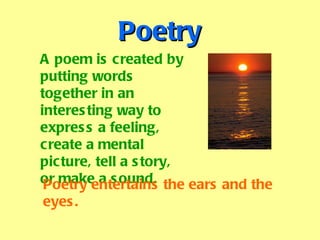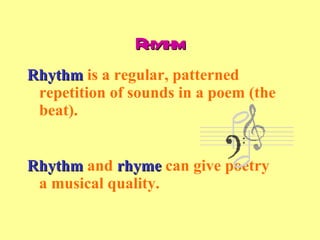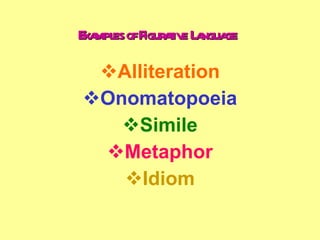4th grade poetry
- 1. Poetry A poem is created by putting words together in an interesting way to express a feeling, create a mental picture, tell a story, or make a sound. Poetry entertains the ears and the eyes.
- 2. Poems Everywhere Poems can be found in many places. They are in your reading book and in lots of places in and out of school. You might have a collection of poems in one book all written by the same author, like this book by Shel Silverstein~
- 3. Or you might find a collection of poems, written by various authors, but printed in the same book. This is called an anthology .
- 4. Poetry Parts: Verse and Stanza Verse ~ usually means a line of poetry, but sometimes means a whole poem: Dust of Snow by Robert Frost The way a crow Shook down on me The dust of snow From a hemlock tree Has given my heart A change of mood And saved some part Of a day I rued.
- 5. Stanza A stanza in a poem is like a paragraph in an essay. Each stanza is usually separated by some blank space. Common stanza lengths are two, three, four, six or eight lines.
- 6. How Many Stanzas Does This Poem Have? Snevington Snee by Jack Prelutsky I’m Snevington Snee And from seven till three I hang by my toes From a coconut tree. I’ve plenty of time And it’s hardly a crime, And no one seems willing To do it for me.
- 7. Rhyme Repetition of end sounds is called rhyme . My dog chewed up my homework. He slobbered on it, too. So now my homework’s ripped to shreds, And full of slimy goo . (~Bruce Lansky)
- 8. Rhyme Scheme Rhyme scheme can be determined by marking similarly rhyming lines of the poem with a letter of the alphabet .
- 9. Rhyme Scheme Here is a poem by Jack Prelutsky with an A-B-C-B rhyme scheme: Grizelda Gratz kept sixty cats A She fed them very well B On angel cakes and raisin flakes C And acorns in a shell . B
- 10. Now It’s Your Turn Can you identify the rhyme scheme of this poem by Mary O’Neill? Green is the grass And the leaves of trees Green is the smell Of a country breeze .
- 11. Consonance The repetition of consonant sounds in nearby words, especially at the ends of words, as in blank and think or strong and string
- 12. Free Verse or Unrhymed Verse Free verse or unrhymed poems do not rhyme or have regular rhythm. American Walt Whitman was one of the first poets to publish free verse poems. I hear America singing, the varied carols I hear, Those of mechanics, each one singing his as it should be blithe and strong, The carpenter singing his as he measures his plank or beam, The mason singing his as he makes ready for work, or leaves off work… ~(From I Hear America Singing by Walt Whitman)
- 13. Rhythm Rhythm is a regular, patterned repetition of sounds in a poem (the beat). Rhythm and rhyme can give poetry a musical quality.
- 14. Figurative Language Poets and other writers often use figurative language and other poetic devices to make their writing more interesting and expressive.
- 15. Examples of Figurative Language Alliteration Onomatopoeia Simile Metaphor Idiom
- 16. Alliteration Down the slippery slide they slid Sitting slightly sideways; Slipping swiftly see them skid On holidays and Fridays. ~by Michael Rosen All iteration is when almost all of the words in the line have the same beginning sound.
- 17. Onomatopoeia The rusty spigot sputters, utters a splutter, spatters a smattering of drops, gashes wider; slash, splatters, scatters, spurts, finally stops sputtering and plash! gushes rushes splashes clear water dashes. ~ by Eve Merriam Onomatopoeia is fun to say and easy to remember! It is the imitation of sounds in word form.
- 18. Combination Sometimes a poet will combine two or more literary devices. Can you tell what two devices are used in the verse below? “ ice cubes clinking clatter clink, crazily inside my drink” ~from Ice Cubes by Joan Graham
- 19. Simile “ Arithmetic is where numbers fly like pigeons in and out of your head.” ~ from Arithmetic by Carl Sandburg A simile is a comparison using _____ or _____. Can you fill in the blanks?
- 20. Metaphor “ On the first snowfall there is a pinhole in the pillow of the sky a feather from a white dove is falling from the sky…” (~from On the First Snowfall by Eve Merriam) What makes this an example of a metaphor?
- 21. Idiom An idiom is a phrase whose words have a different meaning other than its original meaning. Don’t worry. The math test on fractions is a piece of cake!
- 22. Enjoy Poetry! Poetry opens up a whole new world that is different from prose. Try these things: Check out a poetry book from the Learning Center. Start a collection of poetry by copying your favorites into a poetry journal. Try your hand at writing some of your own poetry.





















